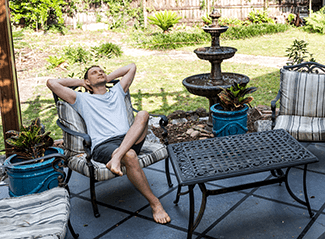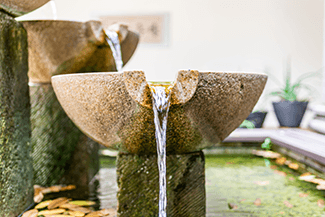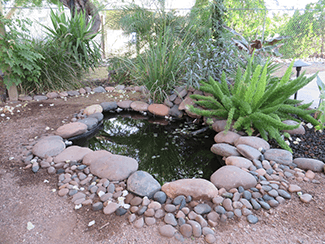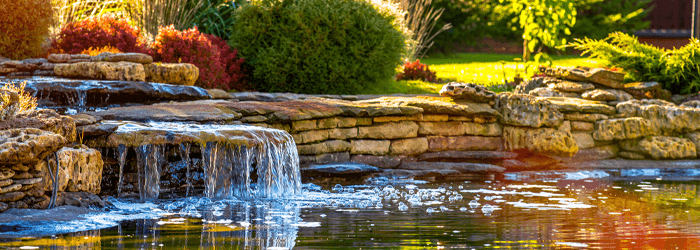Building A Fountain Or A Pond
In Arizona’s primarily desert-like environment, the sound and sight of water (not a flood) elicit a calm and soothing response. You can enjoy those peaceful sounds at home with a fountain, pond, or both.
What is the difference between a fountain and a pond?
Is there a difference between a fountain and a pond? The answer is a definite YES!
If you go to a store and purchase a big tub made of plastic, metal, or concrete, put a water feature in it, and fill it with water, then you have a fountain. Now, that’s a rather basic system, but you can get as extreme and elegant as you like. Fountains are not usually considered a biological system, whereas a pond is. Fountains can be beautiful additions to your home, inside or out. There are literally thousands of premanufactured styles to choose from, or you can build your own.
What differentiates a fountain from a pond is living entities. Ponds contain life – plants and aquatic creatures including fish, frogs, and turtles. Paul Holdeman of the Pond Gnome, calls his creations “Organic Water Gardens.” Ponds keep aquatic life alive and happy. Both provide beauty and ambiance.
Common Reasons for Installing A Fountain and/or Pond.
 Why are ponds and fountains installed? The short answer is sound and aesthetics. The moving water in fountains and ponds create a soothing background sound. The sound can help reduce the impact of noises around your property such as the neighbors, air conditioning units, road noise, and other background urban noises.
Why are ponds and fountains installed? The short answer is sound and aesthetics. The moving water in fountains and ponds create a soothing background sound. The sound can help reduce the impact of noises around your property such as the neighbors, air conditioning units, road noise, and other background urban noises.
Holdeman cautions that the sound created by a pond or fountain will not drown out an 18-wheeler, but it will blend the sounds with the outside noise that will become less noticeable. Sound is a component that designers use to create a more amiable environment. We have all experienced the calming effect sound can have on our psyche. From music to flowing water, sound plays a significant role in our perception of spaces.
Aesthetics speaks more to a sense of place and beauty. In this context, we are talking about how things look. Both fountains and ponds add vibrancy to a space. The movement of water and the decoration provided by a fountain can be bold or subtle. A pond can be large or small while adding the dimension of biodiversity — a living contribution to your special place. When designing a pond, think about which direction you want your space to go, or flow.
Fountain & Pond Maintenance
 There is a difference in the maintenance. The fountain, assuming it is not in a pond, is treated like a swimming pool. The fountain’s purpose is to add beauty and ambiance to a space. The fountain’s size will dictate the equipment needed to maintain clear water and prevent the buildup of algae and other things that might negatively impact the aesthetics. With a fountain, the water should remain clear to highlight the fountain’s design features including the tile and colors. By adding chlorine to the water, the algae are controlled but it can shorten the life of the fountain’s pump. Plus, chlorine is harmful to wildlife and the odor can be off-putting. Use an odorless, mild algicide (like Algaefix) and change the water to keep the fountain clean and healthy.
There is a difference in the maintenance. The fountain, assuming it is not in a pond, is treated like a swimming pool. The fountain’s purpose is to add beauty and ambiance to a space. The fountain’s size will dictate the equipment needed to maintain clear water and prevent the buildup of algae and other things that might negatively impact the aesthetics. With a fountain, the water should remain clear to highlight the fountain’s design features including the tile and colors. By adding chlorine to the water, the algae are controlled but it can shorten the life of the fountain’s pump. Plus, chlorine is harmful to wildlife and the odor can be off-putting. Use an odorless, mild algicide (like Algaefix) and change the water to keep the fountain clean and healthy.
The maintenance of a pond is quite different. In a pond, you want plants and wildlife to thrive in the water. Holdeman explains that the filtration system in a living pond is “sort of a condo for zooplankton and beneficial bacteria. That living biological filter and myriad of plants, fish, and insects are Mother Nature’s janitorial service, keeping the water clean and healthy!”
Living ponds are generally not filtered for particles. They are designed to establish a natural ecosystem. When properly built and maintained it balances itself into a naturally clear water pond. If the water in your pond becomes murky, the balance of living things is off. The good news is that it can be corrected. If you are not sure of the steps to take, contact a professional pond builder before causing further damage to the fragile ecosystem in your pond.
Getting Started Building Your Own Water Feature
 Your first step is to decide the type of water feature to install by understanding the outcome you want. Most decisions revolve around sound and aesthetics. Spend some time researching alternatives. Watching videos about fountains and ponds is a good start. Once you have selected a direction, decide if this is a DIY project or one for a professional. Check out our recent blog about what is a DIY project and projects that should be left to the professionals. The process for deciding how to approach this project is no different.
Your first step is to decide the type of water feature to install by understanding the outcome you want. Most decisions revolve around sound and aesthetics. Spend some time researching alternatives. Watching videos about fountains and ponds is a good start. Once you have selected a direction, decide if this is a DIY project or one for a professional. Check out our recent blog about what is a DIY project and projects that should be left to the professionals. The process for deciding how to approach this project is no different.
If you choose to use a professional, read Rosie’s How to Choose A Contractor Consumer Guide. After you have selected a few contractors to interview, ask for a list their completed projects that you can visit. Take the time to talk with past clients to determine if their goals were met. Ask the clients if there were outcomes they did not anticipate and what they might do differently if they could do it over.
Don’t skip these important steps. You are making an investment in your home, and you deserve all the peace of mind you can get!
###
PODCAST
Adding a soothing, relaxing feature of a fountain or living pond to your home? Know the difference between them. Plus learn about the latest homeowner scams. A follow up on adding antifreeze to concrete or mortar in colder climates. Homeowner questions on earthship homes (we explain what they are), insulation, recaulking shower corners and more!
Podcast Archive With Expanded Content and Resources
PHOTO CREDIT
- Shutterstock















